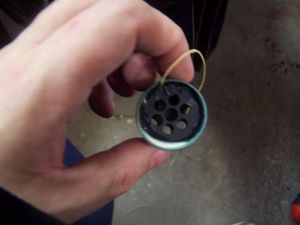| Construction Rating: | starstarstarstarstar |
| Flight Rating: | starstarstarstarstar |
| Overall Rating: | starstarstarstarstar |
| Manufacturer: | FlisKits  |

Brief:
The BAF-55 is a simple baffle intended to protect recovery components from ejection charges in a BT-55 sized body tube.
While building a Refit USS Atlantis from Sirius Rocketry, I decided that I wished to replace the manufacturer's recovery harness with a baffle. I did not have a lot experience with baffles, but the experiences I have had have been good thus far. Fortunately, I happened to have one in stock from FlisKits.
Construction:
The baffle kit came with instructions, a length of Kevlar, two perforated disk that actually form the baffles and a BT-55 sized coupling tube.
Construction of the baffle is simple. The 2 fiber disks are removed from their backing and the holes are punched out. One disk has the holes clustered towards the center and the other has them arranged in a ring around the outside. The one with the outer holes goes to the rear of the rocket. Both disks had a notch along the outside edge through which to pass the Kevlar® thread and the rear disk had a hole intended as an anchor point.
I used an embroidery needle to clear the hole and passed the Kevlar through. I then tied a fat knot in the end of the Kevlar to keep it from being able to pass through the anchor hole. I also used plenty of yellow glue to hold it down. When the glue holding the Kevlar was dry, I proceeded to paint both sides of both disks with the same glue, taking care to keep any from getting on the edges of the disks. This glue was applied to form a protective/ablative surface and lengthen the life of the baffle.
When the protective glue was dry, I glued the rear disk in place in the coupling tube and secured it with a glue fillet. This was done as the Kevlar was passed back through the notch on the outer edge of the disk. I then applied the glue to the Kevlar running along the side to the tube to keep it in place. When that was dry, I painted the entire interior of the tube with glue, again for protective purposes.
The last step of the actual baffle assembly was to fit the Kevlar through the notch in the upper disk and then seat that disk in the tube. Again, the disk was filleted.
PROs: Well designed, easy to make and use.
CONs: None.
Construction Rating: 5 out of 5
Flight:
I have to admit, when I first flew the Atlantis, I forgot I had installed this baffle so I stuffed it full of dog barf. Between that and the baffle, the chute was well protected on deployment with the ejection from a D12-5.
I remembered on the second flight, using an E30-4 but it didn't really matter. The chute had not a scorch mark on it, and the rocket recovered safely. The thing works and works well.
PROs: It works well.
CONs: I forget about it.
Flight Rating: 5 out of 5
Summary:
If you want to use a baffle, all of the FlisKits ones I have used to date have worked well. The one for the BT-60 is no exception.
Overall Rating: 5 out of 5
 |
 |
L.V. (June 19, 2010)
 |
 |
HWH (November 20, 2008)